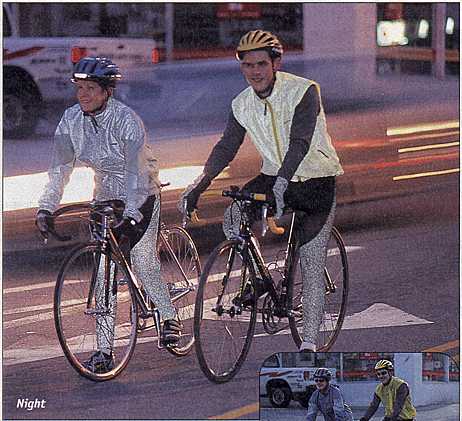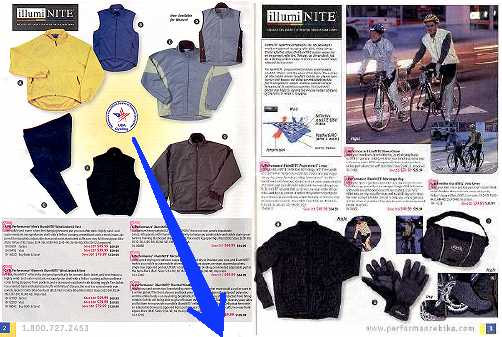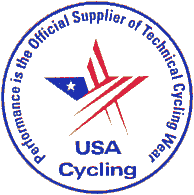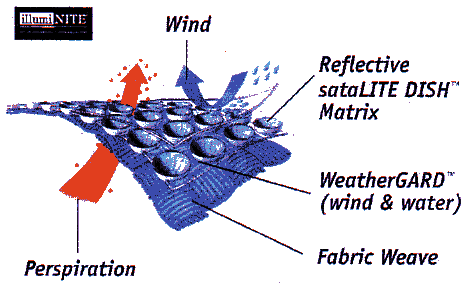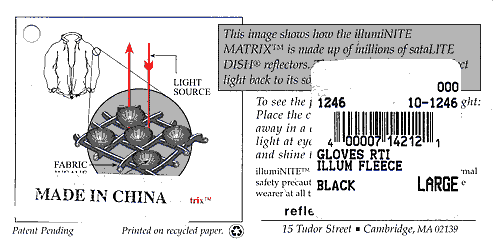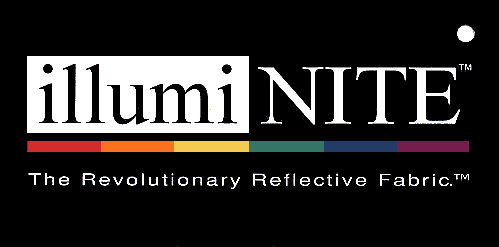Here are my answers. If you have other answers, or comments, please feel free to e-mail me about them. First: why are these people smiling?Smiles are contagious. Advertisers know this, and would like to have us shed our cares, buy their products and and feel like one big, happy family. Above all, remember that the smiling people in ads are smiling because they are being paid! Anyone who showed up to pose for this ad and didn't feel like smiling would quickly have been replaced. Some product promotions certainly do deserve to make you smile, but others might not. Now, on to the more substantial questions. Does the promotion put the public at risk?If you think that the problem is that the bicyclists are in a left turn lane, then I disagree. Their position on the road is perfectly legal, and is reasonably safe too, if they are properly equipped. You may read my Bicycling Street Smarts pamphlet for further explanations. My main concern is that the promotion implies by example that bicyclists can safely ride at night when using garments made of reflective fabric as their only protection. The photo omits equipment which is required by law and for which the reflective fabric can not substitute. Leaving out the other equipment concentrates readers' attention on the reflective fabric product and gives a misleading impression of the product's capabilities. Neither of the bicycles has a headlight. For night riding, a headlight is required by law, to alert people to the approach of the bicycle -- even when not necessary to light the bicyclist's way. Bicyclists who do not use a headlight are more likely to have collisions. When one occurs, these bicyclists increase their risk of being sued and reduce their chance of collecting on anyone else's insurance. None of the usual reflectors are to be seen on the bicycles, either. Have another look.
Reflective material works only for the driver of a vehicle whose headlights are pointed at it. The photo was taken from the direction of a motorist preparing to cross in front of the bicyclists. The motorist's headlights would point straight ahead rather than diagonally to the right toward the bicyclists. Reflectors also are of no use whatever in alerting pedestrians to the approach of a bicycle. Only a bicyclist's headlight is effective in these situations. On-camera flash, apparently used in taking this photo, guarantees that the reflective fabric will shine, even though the photo was taken from a direction in which the reflective fabric would be of little practical use. (There is a more extended discussion of the characteristics of reflectors elsewhere on this Web site.) In text on the catalog pages, claims are made that the fabric makes bicyclists visible to car drivers, e.g., "illumiNITE® ensures that car drivers see your full silhouette..." These statements are not accompanied by any warning about the equipment required by law or the limitations of reflectors. The problems with the promotion apparently originated with Performance. Peter Smith, President of Reflective Technologies, manufacturer of illumiNITE, was kind enough to return my telephone call. When I described the promotion, he replied "it gives the consumer the wrong impression...I will pass that along." Does the product meet appropriate standards?State laws have specific requirements for reflectors, which the reflective fabric items do not meet because of their unusual shapes, sizes, color and locations. If the reflective fabric items perform well, a case can nonetheless be made that they constitute an adequate substitute for the required reflectors -- though not for lights. How well do the reflective fabric items perform? In the photo, and despite the contrived lighting conditions, only the man's jacket is significantly brighter than unreflectorized items in the background. The reflective tape on the woman's helmet -- the one visible reflective item on either bicyclist other than the clothing -- is many times brighter and completely saturates the photographer's film to white. I purchased a pair of illumiNITE reflective gloves for testing and found that they were not markedly brighter than a plain sheet of white paper, even under the most ideal lighting conditions. One obvious reason was that only a gridlike pattern of lines covering about 15% of the gloves' surface area had the reflective treatment. In my testing, I also found that the fabric partially loses its reflective properties when wet. The American National Standards Institute has standards for reflectivity, and I seriously doubt that this product meets them. Tests are pending. On the other hand, I have also examined a jacket made of illumiNITE reflective fabric. It is much brighter, and it retains its reflectivity when wet. Much more of the jacket's surface area has the reflective treatment, and the jacket has a transparent coating which isolates the reflective elements from water. This jacket is yellow. I consider it a reasonable supplement to the lights and reflectors required by law. There appears to be a tradeoff between reflectivity and comfort. The owner of the jacket told me that she found that it did not "breathe" adequately. I have seen a similar complaint in a posting by another bicyclist to an Internet newsgroup. Perhaps some illumiNITE garments, including the gloves I purchased, have been designed for greater comfort at the expense of decreased reflectivity. In our telephone call, Smith made the point that the human brain is attracted to brightness, but also to shape, and that the goal of the reflective fabric is to combine brightness with shape. I could add that a very large reflective area compensates somewhat for low reflectivity. However, there is another problem: 8 of the 11 items displayed the two-page spread of reflective fabric items in the Performance Bicycle catalog (below) are black or dark-colored. In any direction except that from which headlights are shining, these items appear dark. Only one item (the man's jacket) is in high-visibility yellow, though it is also available in dark blue. The man's vest is also available in yellow, as shown in the photo of the bicyclists. Smith indicated to me that "certain consumers would not buy jackets if they're in a fluorescent color...some cyclists are safety conscious and some are not. There's an education job still out there in terms of communicating to consumers the importance of visibility." He would rather provide clothing that has visibility in one way (reflectivity) even if it does not in another (bright color). I consider that there is still a problem with leading consumers into thinking that a dark jacket with reflective properties is as good as or better than a light-colored one without. |
